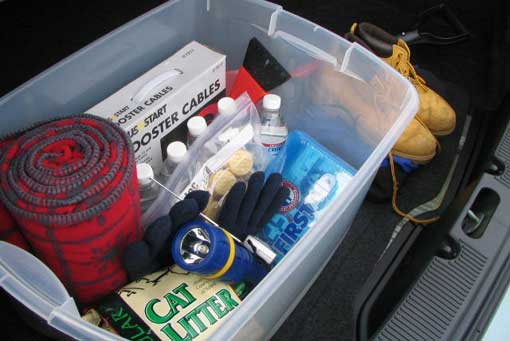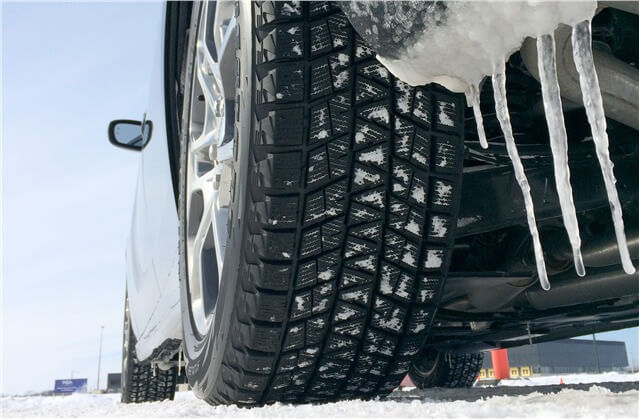It’s (unfortunately) getting to be that time when winter weather can affect road conditions — and leave drivers potentially open to getting stuck in the snow.
When you live in a place like Western New York with cold, snowy winters, it’s important to always be prepared for the worst while driving. Since some KenDev residents aren’t from the Buffalo area and may not be used to driving in poor conditions, we’ve put together some tips on preparing your car for the winter.
Prepare a Winter Safety Car Kit
Preparing a winter safety car kit is the most important thing you can do to prepare your car for winter. We recommend everyone keeps a kit in their car that can be used if you face an emergency situation on the road, such as being stranded or stuck in a snowstorm.

- A shovel
- Windshield scraper and small broom
- Flashlight with extra batteries
- Battery powered radio
- Bottled water
- Non-perishable snacks, including energy bars, raisins and mini candy bars
- Matches and small candles
- Extra jacket, hats, socks and mittens
- First aid kit with pocket knife
- Necessary medications
- Blankets or sleeping bag
- Tow chain or rope
- Road salt, sand, or cat litter for traction
- Booster cables
- Emergency flares and reflectors
- Fluorescent distress flag and whistle to attract attention
- Cell phone adapter to plug into lighter and a portable phone charger
You may also want to consider a travel tire inflator, de-icing spray for your windshield and wipers and a portable car battery charger.
Consider Using Snow Tires
Most vehicles have “all-season” tires, which give you some inclement weather performance when they are fairly new. However, according to U.S. News, they don’t have the technology or tread design necessary for extreme weather. And if your car has special summer or performance tires, you’ll definitely want to switch them out for something that has more traction.
Winter tires are different than all-season or summer tires in several ways. Their tread designs are optimized for winter traction, and the part of the tire that contacts the road is formulated to stay flexible to maximize grip on the road. This is extremely helpful on snowy or icy roads.

Your snow tires should be fitted to your vehicle, and shops like Dunn Tire can help you find quality snow tires that make winter driving easier and safer. You’ll sacrifice some gas mileage, but many drivers find it to be worth it.
Regardless of what tires you choose, you’ll want to make sure your tires are in good shape with plenty of tread and adequate air pressure before you hit the road.
Tire pressure can drop along with the air temperature, losing up to one pound per square inch with every 10-degree drop in air temperature. Underinflated tires can make it more difficult to stop and handle in winter conditions, so you definitely want to make sure you keep them inflated at the correct level.
Keep Your Car in Good Condition
Besides putting together a car safety kit and ensuring your tires are ready for winter, there are several other steps you should take to prepare your car for extreme conditions.
Here are some additional steps you should take to keep your car in good condition for winter driving, according to U.S. News and Autotrader:
- Check your engine coolant/antifreeze levels. Antifreeze keeps your engine from freezing, which is particularly important if you’re stranded. Over time, this liquid will gradually get used up, so it should be checked every 3 to 6 months. You can purchase a kit for checking your engine coolant levels at most auto supply stores. You can also check your antifreeze levels by following the instructions in your car’s manual.
- Use winter windshield wiper fluid. Regular fluid that you use in warmer seasons can freeze quickly upon contact with your windshield. Winter fluid won’t freeze and helps loosen ice and snow from your windshield, making it much easier to keep things clear.
- Switch to a winter-grade oil at your next oil change. In general, the colder the weather, the thinner you want the oil in your engine to be. Ask your mechanic about switching, and make sure you’re getting regular oil changes.
- Check your battery. It’s usually more difficult for a battery to operate in cold weather than warm weather. We recommend having a volt test performed on your battery before winter starts to make sure it’s strong enough to start in cold winter temperatures. If it isn’t, replace it as soon as possible. You don’t want to be left with a car that won’t start in a cold parking lot this winter.

- Make sure your defroster and climate control are working properly. This is crucial for comfort and safety in the winter. The heat will warm you up while preventing windows from fogging, and the defroster will keep your windows from icing up.
- Check that all of your car lights are in good shape. Snowy conditions can make for low visibility, and with limited daylight during the winter, you want to make sure other drivers can always see your car–and you can see them.
- Don’t drive in bad weather with less than half a tank of gas. It’s a good idea to always have gas in your tank just in case you face an emergency situation on the road and need to keep the car on for heat. And according to Autotrader, a full tank may prevent accumulated water from freezing inside your fuel pump.
- Consider a remote starter. While not a necessity, it makes the morning commute much better — and can help you remove snow and ice from your car more quickly when you’re rushed before work.
What are your best tips for preparing your car for winter? Let us know in the comments.

 Fair Housing Notice
Fair Housing Notice 